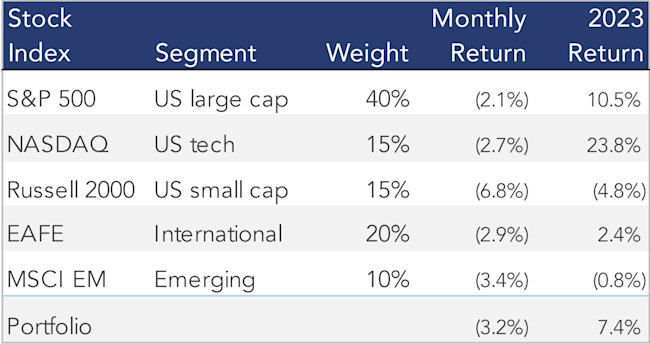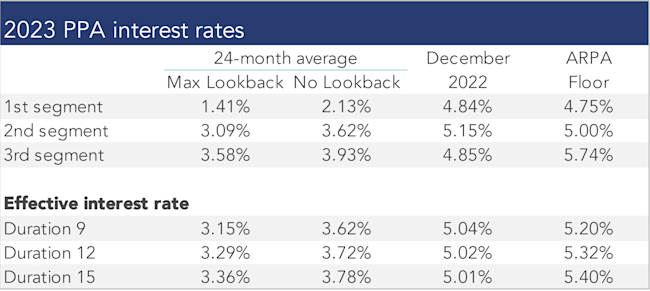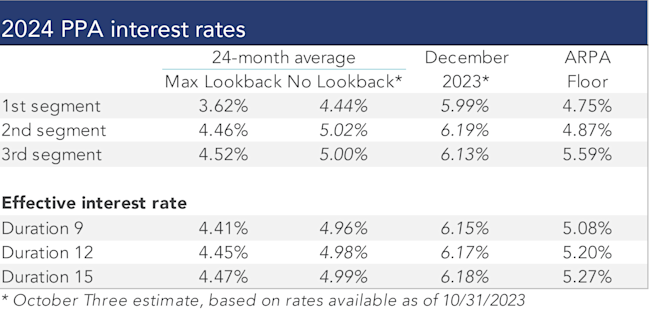Pension Finance Update October 2023
Pension finances were tricked by falling stock markets but treated by higher interest rates in October, a pattern repeated for three straight months now, producing modest declines for pension sponsors.
Pension finances were tricked by falling stock markets but treated by higher interest rates in October, a pattern repeated for three straight months now, producing modest declines for pension sponsors. Both model plans we track(1) edged lower last month: our traditional Plan A lost a fraction of 1% but remains up 8% for the year, while the more conservative Plan B also lost a fraction of 1% in October, but remains 1% ahead through the first ten months of 2023:
(1) Plan A is a traditional plan (duration 12 at 5.5%) with a 60/40 asset allocation, while Plan B is a largely retired plan (duration 9 at 5.5%) with a 20/80 allocation with a greater emphasis on corporate and long-duration bonds. We assume overhead expenses of 1% of plan assets per year, and we assume the plans are 100% funded at the beginning of the year and ignore benefit accruals, contributions, and benefit payments in order to isolate the financial performance of plan assets versus liabilities.

Assets
Stocks fell again in October, pushing small cap and emerging market stocks into negative territory for the year, while large cap and tech have still managed double-digit returns through October. A diversified stock portfolio lost 3% last month but remains up more than 7% through the first ten months of 2023:

Bond yields rose another 0.3% in October, with Treasuries reaching 5% yields and Aa corporates hitting 6%. As a result, bonds lost 2%-4% last month. For the year, a diversified bond portfolio is now down 3%-9%, with long duration Treasuries doing worst.
Overall, both plans we track lost ground last month: Plan A lost 3% during October but remains up 2% for the year, while Plan B lost 2% last month, ending October down 2% for the year.
Liabilities
Pension liabilities (for funding, accounting, and de-risking purposes) are driven by market interest rates. The first graph below compares our Aa GAAP spot yield curve at December 31, 2022 and October 31, 2023, and it also shows the movement in the curve last month. The second graph below shows our estimate of movements in effective GAAP discount rates for pension obligations of various duration so far this year:

Corporate bond yields increased 0.3% during October. As a result, pension liabilities fell 2%-4%, ending the third quarter down 3%-10% for the year, with long duration plans seeing the largest drops.
Summary
Pensions have endured a 10% drop in stocks since the end of July on the strength of interest rates increasing almost 1% at the same time. The graphs below underscore the power of higher rates for pension sponsors, which have translated to generally positive news during the first ten months of 2023:

Looking Ahead
Pension funding relief was signed into law during March of 2021, and additional relief was provided by November 2021 legislation. The new laws substantially relaxed funding requirements over the next several years, but if the 3% increase in interest rates seen since 2019 holds, “relief” will result in 2024 funding targets higher than market liabilities, in some cases forcing plans to overfund.
Discount rates jumped across the board last month, while a flat yield curve continues to compress rates for plans of different durations. We expect most pension sponsors will use effective discount rates in the 5.9%-6.1% range to measure pension liabilities right now, the highest rates seen since 2009.
The table below summarizes rates that plan sponsors are required to use for IRS funding purposes for 2023, along with estimates for 2024. Pre-relief, both 24-month averages and December ‘spot’ rates, which are still required for some calculations, such as PBGC premiums, are also included.


